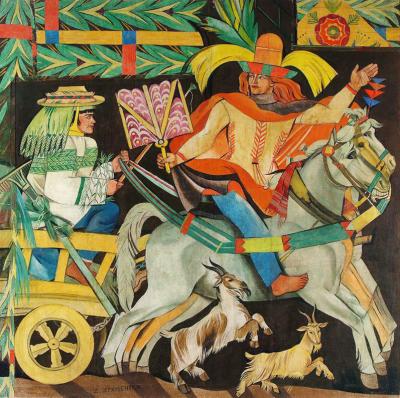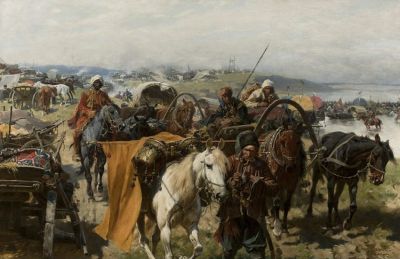Stryjeńska, Zofia

Stryjeńska, Zofia (née Zofia Lubańska, "Tadeusz von Grzymala"), Polish painter, graphic artist, set designer and designer, member of the "Munich School". In 1911/12, she was at the Academy of Fine Arts in Munich and in the group surrounding Wassily Kandinsky. *13 May 1891 in Kraków, †28 February 1976 in Geneva. Daughter of the President of the Kraków Chamber of Commerce, Tadeusz Grzymała Lubański, and his wife Anna, née Skrzyńska, four siblings; wife of the architect Karol Stryjeński (1887-1932), three children. After briefly attending the Kraków trade school, the teacher training college and the private art school of the painter Leonard Stroynowski (1858-1935), from 1909 Zofia Lubańska attended Maria Niedzielska’s Art School for Women/Szkoła Sztuk Pięknych dla Kobiet Marii Niedzielskiej, which she completed with a silver medal for painting and applied art the year after she finished her travels to Vienna, Triest and Venice in 1910. On 28 October 1911, she wore men’s clothing and used her brother Tadeusz Grzymała’s passport in the name of "Tadeusz von Grzymala" to join the drawing class of Gabriel von Hackl (1843-1926) at the Royal Academy of Fine Arts in Munich because women were not allowed to study at the Munich Art Academy at that time. She moved in the circles surrounding Wassily Kandinsky and was interested in dance, ballet and the rhythm theories of the Swiss composer and music teacher Émile Jaques-Dalcroze (1865-1950). In 1912, her charade as a man was exposed and she returned to Kraków, where she devoted herself to painting and literature. An exhibition of cartoons created whilst in Munich with decorative scenes from Polish folk tales at the Society of the Friends of Fine Art in Krakow/Towarzystwo Przyjaciół Sztuk Pięknych w Krakowie made her very popular with the public and in the press reviews. She subsequently received her first commissions for murals. She established close relationships with the artist community of the Kraków Workshops/Stowarzyszenie Warsztaty Krakowskie, which were founded in 1913 and which campaigned for the restoration of craftsmanship and applied arts based on folk art. Finally, she also established links to literary and artistic circles, such as those surrounding the poet Tadeusz Boy-Żeleński (1874-1941) and the painter of battle scenes Wojciech Kossak (1857-1942, member of the "Munich School"). During the First World War, she continued to work on illustrations for fairytales and musical-literary genres, and designed costumes and sets for performances of fairytales in theatres. In November 1916, she married the architect Karol Stryjeński (divorced 1927). In 1918, she became a member of the Kraków Workshops, designed tapestries, theatre and ballet scenery and costumes, as well as toys and dolls in regional dress. In 1918, she established a close relationship with the Polish futurist from the Gałka Muszkatułowa group surrounding the painter and poet Tytus Czyżewski (1880-1945). In 1920/21, she exhibited her works at numerous exhibitions in Kraków, Venice and Paris. In 1922, she joined the Rytm Artists’ Association/Stowarzyszenie Artystów Polskich "Rytm" and, despite its members coming from various artistic traditions, they all acted together to propagandise for a restoration of the decorative arts based on folk art. Stryjeński exhibited with them until 1929. In 1923, she moved with her family to Zakopane, where she made friends with the author Stanisław Ignacy "Witkacy" Witkiewicz (1885-1939) and the painter Rafał Marceli Malczewski (1892-1965). In 1925, in the Polish pavilion that she had designed for the Exposition internationale des Arts Décoratifs et industriels modernes in Paris, she showed six large-format paintings of rural life at the change of the seasons. Awarded the Grand Prix for painting, poster art, illustration and textile designs, an honorary degree in the field of toys and appointed Chevalier de la Légion d’Honneur, she was subsequently awarded numerous state commissions in Poland for painting cycles, facade decorations on Warsaw town houses and the furnishing of salons on ocean-going liners.
After marrying again, changing religion and moving, (Warsaw, 1929-30 Vilnius), during the Second World War she lived in Kraków and Poronin. In 1946, to avoid the state appropriating her art, she emigrated to Switzerland, then travelled through Europe, lived in Paris from 1951 to 1960 and in Geneva from 1962, where she died largely forgotten and in poverty. – It appears evident that Stryjeński had been influenced in Munich by Wassily Kandinsky’s colourful and two-dimensional figure compositions, and particularly by his religious compositions grounded in folk art ("All Saints’ Day", "St Vladimir", both 1911). According to Anna Król (2020), however, her style is particularly "associated with the search for a [Polish] national style and this was certainly one of the reasons it was so popular". From her first exhibition in 1912, where she showed the cartoons that she had created whilst still in Munich, she was considered a “creator of national art” in Poland, and in the 1920s, in the resurrected Polish state, she was seen as a "representative of the folkloric variant of Art Déco" (ibid). From today’s perspective, her broad areas of work encompassing free, decorative and applied art can be understood as a contribution to the pursuit for the complete work of art. In her paintings, which are mostly in opaque colours on paper or board and less frequently in oil on canvas, she combines narrative, figurative imagery with a geometric style and rhythmical surface composition in bright colours. She borrowed a humorous, and sometimes grotesque concept of man from folk art. Along with patriotic representations relating to the aim for or recently achieved Polish independence, which also appear in religious subjects, her work is dominated by representations of Polish rituals, customs and traditions dating far back in history. She studied traditional Polish costumes and was fascinated by the Slavs’ world of Gods and beliefs. In her portfolio "Bożki słowiańskie/Slavic Gods" (1918), she developed her own iconography which she reverted to in paintings, illustrations and stage sets in the decades that followed. Her work for the theatre was much more satisfying to her than ‘free’ painting and included the drama "Balladyna" (1835) by Julius Słowacki (1809-1849) to mark the transportation of the poet’s remains to the Wawel (1927) and costumes for the ballet "Harnasie" (1935) by the composer Karol Szymanowski (1882-1937). In her book art, she illustrated Polish authors and created bibliophile editions. She developed a series entitled “Polish dances” for postcards and advertising (chocolate packaging). The toys created by her were dominated by colourful building blocks and wooden figures ("Wawel dragon"). In textiles, she created kilims, batik work and clothing fabrics. She supplied designs to the porcelain factory in Ćmielów. Her works, which were mass produced, were also used in schools to reassess folk art and history. Her works can be found in the National Museums in Kraków, Poznań, Warsaw and Wrocław and in numerous Polish museums and libraries. At the Berlin Biennale in 2008, the Polish painter Paulina Ołowska (*1976, 2015 Aachen art prize) exhibited pictures from her own series "Zofia Stryjeńska" together with some of her predecessor’s work. A painted floor work made reference to the Polish Pavilion designed by Stryjeńska in Paris in 1925.
Solo exhibitions: 1912 Kraków, Society of the Friends of Fine Art/Towarzystwo Przyjaciół Sztuk Pięknych w Krakowie / Warsaw: 1919, 1926 Society for the Promotion of Fine Arts/Towarzystwo Zachęty Sztuk Pięknych; 1935 Instytut Propaganda Sztuki / 1924 Kraków, Society of the Friends of Fine Art/Towarzystwo Przyjaciół Sztuk Pięknych / 1927 London, New Art Salon / 1932 Lwów, Muzeum Przemysłu Artystycznego / 2008 National Museum, Kraków/Muzeum Narodowe w Krakowie / 2009 National Museum, Poznań/Muzeum Narodowe w Pozaniu, National Museum, Warsaw/Muzeum Narodowe w Warszawie
Group exhibitions: From 1912 onwards, regular exhibitions in Kraków, Society of the Friends of Fine Art/Towarzystwo Przyjaciół Sztuk Pięknych w Krakowie and Warsaw, Society for the Promotion of Fine Arts/Towarzystwo Zachęty Sztuk Pięknych / 1920, 1930, 1932 Venice, Biennial / 1925 Paris, Exposition internationale des Arts Décoratifs et industriels modernes (Polish Pavilion)
Literature: Halina Stępień/Maria Liczbińska: Artyści polscy w środowisku monachijskim w latach 1828-1914. Materiały źródłowe, Warsaw 1994, page 25, 62; Polski Słownik Biograficzny, vol. 44, 2006/07 (further literature there); Światosław Lenartowicz (publisher): Zofia Stryjeńska 1891-1976, Exhibition catalogue: National Museum, Kraków/Muzeum Narodowe w Krakowie, 2009; Anna Król, in: De Gruyter Allgemeines Künstlerlexikon, vol. 106, Berlin/Boston 2020, page 490-492 (further literature there)
Online: Matriculation database, matriculation register 3, Academy of Fine Arts, Munich, 05013 Tadeusz von Grzymala, https://matrikel.adbk.de/matrikel/mb_1884-1920/jahr_1911/matrikel-05013
Numerous works in the National Museum, Warsaw/Muzeum Narodowe w Warszawie, https://cyfrowe.mnw.art.pl/pl/artysci/5264
Numerous works in the National Museum, Kraków/Museum Narodowe w Krakowie, https://zbiory.mnk.pl/pl/wyniki-wyszukiwania?phrase=Stryjenska
Jolanta Laskownicka, on Internetowy polski słownik biograficzny (further literature there), https://www.ipsb.nina.gov.pl/a/biografia/zofia-stryjenska-z-domu-lubanska-1891-1976-malarka
Relating to the exhibition by Paulina Ołowska 2008 in the Schinkel-Pavillon in Berlin, https://www.berlinbiennale.de/de/projekte/1316/zofia-stryjeska
Natalia Mętrak: Artist, Mother, Man: The Diaries of Zofia Styjeńska, on culture.pl, featuring a photograph of Zofia Lubańska (Tadeusz von Grzymala) with a group of her fellow students at the Munich Art Academy, https://culture.pl/en/article/artist-mother-man-the-diaries-of-zofia-stryjenska
(All links last retrieved in October 2020)
Axel Feuß, October 2020


![In the Park/W parku, Munich or Lwów 1910. Watercolour over pencil on board, 46 x 33 cm, signed bottom right: Stefanowicz [1]910, at auction (Agra Art, Warsaw 2019) In the Park/W parku, Munich or Lwów 1910. Watercolour over pencil on board, 46 x 33 cm, signed bottom right: Stefanowicz [1]910, at auction (Agra Art, Warsaw 2019)](/sites/default/files/styles/width_100_tiles/public/Stefanowicz%20Kajetan.jpg?itok=BqYT6lfQ)
